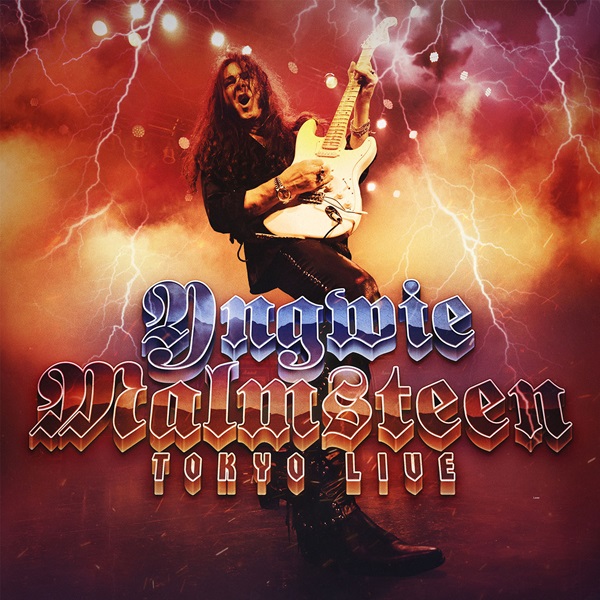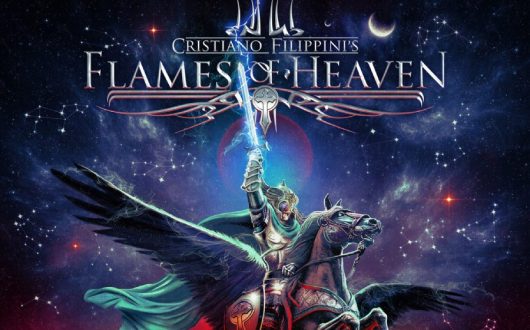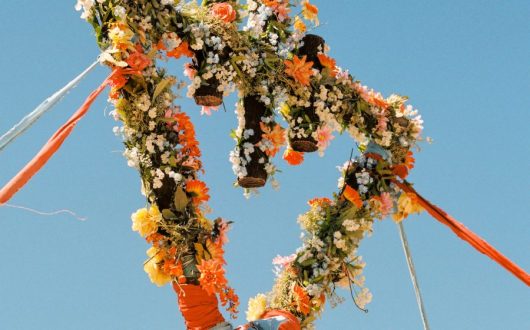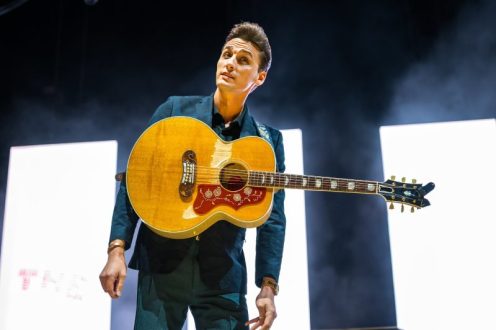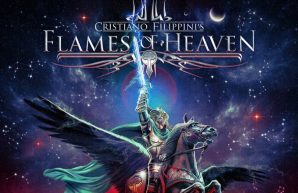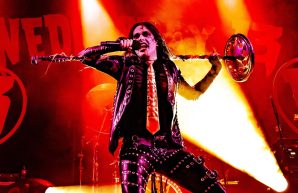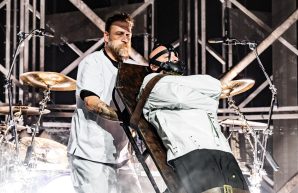Interview by Adrian Hextall
Forty years. Four decades. Let that sink in. It’s an eternity in the fickle world of rock ‘n’ roll, a timespan that has seen genres rise and fall, titans crumble, and trends fade like yesterday’s T-shirts. Yet, standing defiant against the ravages of time, wielding his signature Fender Stratocaster like a mythical weapon, is Yngwie J. Malmsteen. The Swedish-born fretboard wizard didn’t just crash the party in the early 80s; he kicked the door off its hinges, unleashing a torrent of neoclassical shred pyrotechnics that fundamentally rewired the DNA of heavy metal guitar. Now, celebrating an incredible 40th anniversary as a solo artist, Malmsteen isn’t dusting off his museum pieces. He’s sharpening his plectrum, cranking the Marshalls, and proving, with the visceral energy of his new live album, Tokyo Live, that the fire burns hotter than ever.
We caught up with the Maestro himself, expecting perhaps a touch of reflection, maybe a hint of laurel-resting. What we got was pure, undiluted Yngwie: a force of nature, brimming with relentless creative energy, utterly dismissive of nostalgia, and still operating with the same boundary-pushing, improvisational zeal that made him a legend.
“Congratulations on 40 years, an incredible milestone,” we offer, perhaps stating the obvious but meaning it sincerely. Many artists hitting this mark might be forgiven for slowing down, for looking back. Not Yngwie.
“Well, thank you very much,” he replies, his voice retaining that familiar, slightly accented cadence now honed by decades living Stateside (“I don’t really have any Swedish people around me, you know? So it’s all in English,” he confirms). Then comes the kicker, delivered with the conviction of a man possessed: “I feel like I’m just getting started.”
He means it. You can hear it in his voice, the same passion that must have crackled when he first plugged in. “It doesn’t get old for some fucking weird reason,” he laughs. “Because of that, I’m still here.” Forget burnout; for Malmsteen, the constant challenge is the fuel. So, how does one stay inspired after 40 years sculpting sonic assaults?
“I think the main reason is because everything I do is improvised,” he explains, getting to the absolute heart of the Malmsteen method. “Every time I pick up the guitar… something happens. I say, ‘Oh, wow.’ And I run up in the studio, I start recording it, and it snowballs from there, you know? And the same thing when I’m on stage. I don’t play the same solos. I don’t play the same intros. I play the same skeleton of the arrangement, you know? But I challenge myself… every night.”
This isn’t just idle talk; it’s a fundamental philosophy. Forget meticulously recreated studio perfection. A Malmsteen live show is a tightrope walk without a net, a unique event forged in the heat of the moment. Even the setlist is merely a suggestion, often discarded mere moments before hitting the stage, or even mid-show.
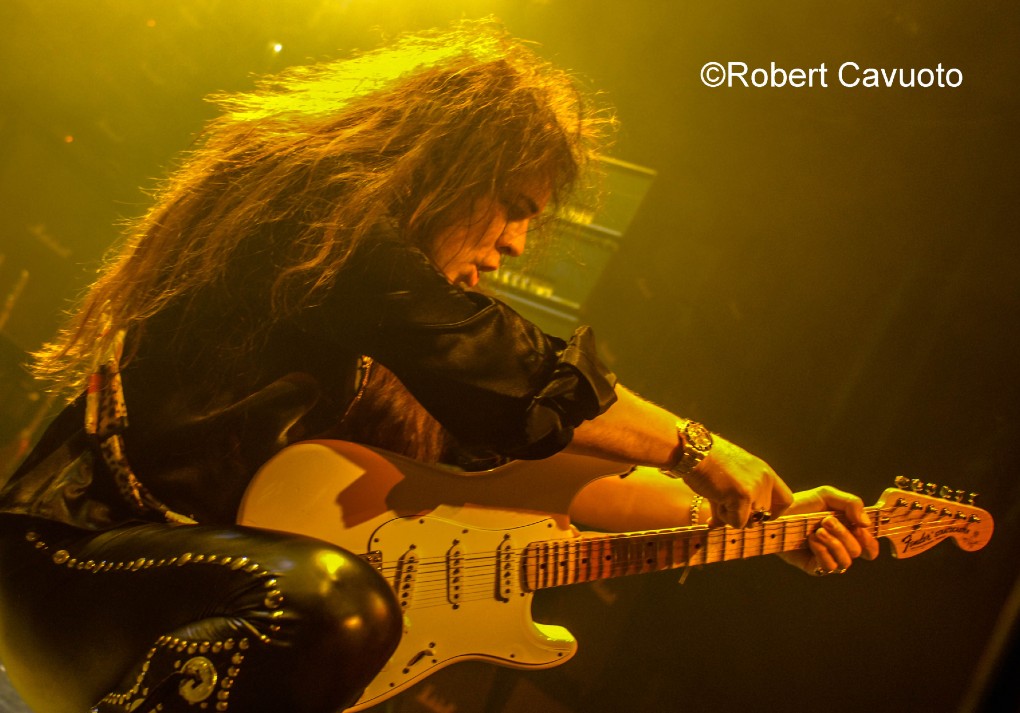
“Every night before the show, I tell the guys, ‘Come in my room. We’re gonna do this set tonight.’ And then they go to the promoters and they print it out. I go on stage and I still don’t play that set! I change anyway,” he reveals, chuckling. “And they know this! It’s basically a full interaction with the audience where I can sense, ‘This is not right for this moment,’ you know? This song is not right here. Or I might just take it and play it later in the set when they’re more warmed up, whatever. I don’t like to be like, planned in, you know? I want to just do whatever feels right.”
He contrasts this with more structured touring environments, like the G3 tours he participated in alongside players like Joe Satriani, Steve Vai, Zakk Wylde and Nuno Bettencourt. “It was really regimented,” he recalls. “You play a song with them… and then Zack and Steve and I go on… and I can’t go over [time] because we all go back together afterwards… It was great, but it was different from what I do. I demand the freedom, you know. If they tell me there’s a curfew at 11 PM, I tell them they better put me on by 8:30! Because I may play that long. I may not. But you want the opportunity to be able to, if you feel like it.”
It’s this relentless pursuit of the spontaneous spark that keeps both him and his audiences perpetually on their toes. Fans attending multiple shows know they’re not just getting variations on a theme; they’re witnessing entirely different flights of fancy each night. It’s like the old Warner Bros. cartoon character Wile E. Coyote, perpetually running off cliffs yet somehow always returning for the next scheme. “Hopefully, like Wile E. Coyote, you just keep flying over the cliff, you know, and clear land or something soft,” Yngwie jokes. “And you always come back to do it again the next day.”
This ethos feeds directly into the new live album, Tokyo Live. Given the anniversary and Japan’s legendary reverence for Malmsteen (dating back to his explosive arrival with Steeler and Alcatrazz), one might assume the Tokyo show was strategically chosen, meticulously planned as the 40th-anniversary document. The reality? Almost a happy accident.
“It’s funny you say that because that’s not how it happened at all,” Yngwie clarifies. “It’s like a full circle thing. I went there to Japan with a different band [Alcatrazz] in January 1984. And they pretty much had a fucking meltdown… they liked what I did. So they said, ‘You have to have a solo album.’ So they gave me a solo deal.” Fast forward nearly four decades: “I did an album a couple of years ago called Parabellum and I was on tour with that all around the world. By the time we got to Japan… somebody said, ‘Oh, it’s the 40th anniversary of your solo career.’ Oh, okay, let’s call it that! So we come to Japan and the promoter says, ‘Hey, we wanna film the show, just to have it.’ Not even an official thing. I say, ‘Oh yeah, film it, record it. And if I like the footage and the sound, I will release the live album.’ That’s what happened!”
“I think it comes from growing up as a kid in Sweden because all I was told was how shit it was,” he states bluntly. “‘Oh, you’re never gonna make it. What the fuck are you doing, you know, playing like that?’ Because it was so outrageous. I did neoclassical shit in the 70s, in the fucking 70s, okay? And metal, like really deep tuned down to C sharp, like heavy fucking shit. And that was just from my own, from within. I didn’t hear other bands do that.”
The spark might have been lit by Ritchie Blackmore – “On my eighth birthday, I got a Deep Purple Fireball album… in Sweden in 1971, there was no radio, there was no TV, nothing… He fucking knocked me out.” But Yngwie quickly transcended mere imitation. “After I kind of got a very good handle of the pentatonic scale guitar style playing, I started leaning towards listening to classical violin, where the arpeggios and the pedal notes and the linear harmonic minor and diminished scales… all that stuff became much more intriguing to me.”
The crucial element was the synthesis: “The Marshall Stacks, the double bass drums, and the smoke bombs had to remain, you know! I would never be a classical musician for a second. So it was a combination of these things.” He even found a name for it early on: “I have a tape from 1978 called Powerhouse that I wrote on, it says ‘symphonic metal rock’. No one knew what that… I didn’t even know what the fuck it was that I wrote it, you know! And that was ‘77, ‘78. I was in sixth grade!”

Interestingly, despite the complex improvisation, he rejects any comparison to jazz. “The approach is maybe the same, but the thing is in jazz… you can lean on a G sharp in the key of C and that’s accepted. I never got into that. Because the old Wolfgang Amadeus Mozart, he says, ‘Music is melody.’ And, you know, even if you improvise, you need to know what the guardrails are within that key. You have these notes that belong here; these notes don’t belong there. It’s just a built-in thing.” Hear, hear. In an era often drowning in tuneless technicality, Malmsteen’s unwavering commitment to melody within the mayhem remains paramount.
This singular vision has undoubtedly inspired legions of players, for better or worse. “Yeah, of course,” he acknowledges when asked if guitarists cite his influence. “I think it’s great. I mean, I’m very honoured by that. I think that there’s a little bit of a danger in being too inspired by somebody because it becomes a little too obvious. But I’m not gonna knock it… I’m very, very honoured to have been given all those flattering comments. I’ve also been given some shitty ones! So I take everything in stride.” His early Swedish critics clearly forged an inner resilience. “I don’t allow the bad or good to get too much of an effect… I know what is good and I know what is bad.”
That self-assurance extends to his creative process. He’s a multi-instrumentalist, laying down bass and drums on his records alongside the guitar pyrotechnics. Inspiration is constant, captured whenever and wherever it strikes. “I have guitars all over the place. I’m never far away from one,” he says. Ideas might start on guitar, but not always. “Sometimes I think of the bass first, actually.” He squirrels away riffs, melodies, lyrics (“I wrote the lyrics for ‘I Am A Viking’ on a drinks napkin on the plane home… the song didn’t exist yet!”) on his phone, in the studio. “Sometimes something comes out that will fit perfectly with that chord progression over there, you know? It’s not like I’m taking it from someone; it’s taking from my own shit laying around!”
So, what’s next after the Tokyo Live celebrations? With Yngwie, the creative wheels never stop turning. The old ‘album cycle’ is dead. “It used to be a cycle where you make your record… write some songs… rehearse… studio… overdubs… mix… tour… then do the cycle over. But 10, 15 years ago, that was done already. That’s no longer the way we do it anyway. So, I write all the time and tour all the time.” A new studio album is perpetually in the works. “When I think that I have the time and also great material, I say that it’s time to put it all down. I already have a lot of stuff done.” When can we expect it? He remains enigmatic: “I don’t know. Could be tomorrow, could be 10 years!”
Forty years on, Yngwie Malmsteen remains an enigma wrapped in a Stratocaster, fueled by improvisation, classical grandeur, and heavy metal thunder. He operates entirely on his own terms, unburdened by his past (“Zero nostalgia,” he insists. “Today is the new day… Let’s do this now.”) and constantly pushing towards the next sonic frontier. Tokyo Live isn’t just a snapshot of a legacy; it’s a vibrant, electrifying testament to an artist still performing at peak power, still taking risks, still hitting those impossible notes. Go see him live this summer. Crank the live album. Prepare for the Fury. He’s only just getting started.
Tokyo Live – Track Listing
CD1
1. Rising Force (Live)
2. Top Down Foot Down (Live)
3. No Rest For The Wicked (Live)
4. Soldier (Live)
5. Into Valhalla (Live)
6. Baroque & Roll (Live)
7. Like An Angel (Live)
8. Relentless Fury (Live)
9. Now Your Ships Are Burned (Live)
10. Wolves At The Door (Live)
11. Hiroshima Mon Amour (Live)
12. (Si Vis Pacem) Parabellum (Live)
13. Badinere (Live)
14. Paganini’s 4th (Live)
15. Adagio (Live)
16. Far Beyond The Sun (Live)
17. Arpeggios From Hell (Live)
CD2
1. Seventh Sign (Live)
2. Toccata (Live)
3. Evil Eye (Live)
4. Smoke On The Water (Live)
5. Trilogy-Vengeance (Live)
6. Cadenza 1 (Live)
7. Brothers (Live)
8. Fugue (Live)
9. Cadenza 2 – Grand Finale (Live)
10. You Don’t Remember I’ll Never Forget (Live)
11. Acoustic Cadenza (Live)
12. Black Star (Live)
13. I’ll See The Light Tonight (Live)
BUY HERE: https://lnk.to/yngwiemalmsteen
